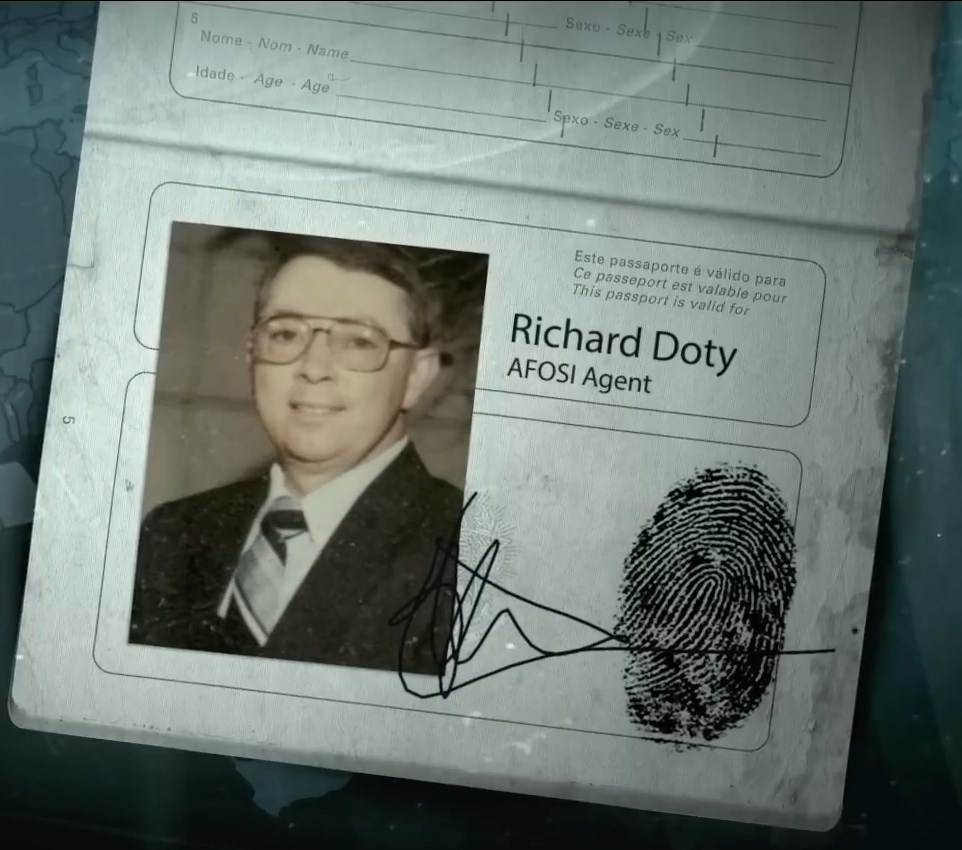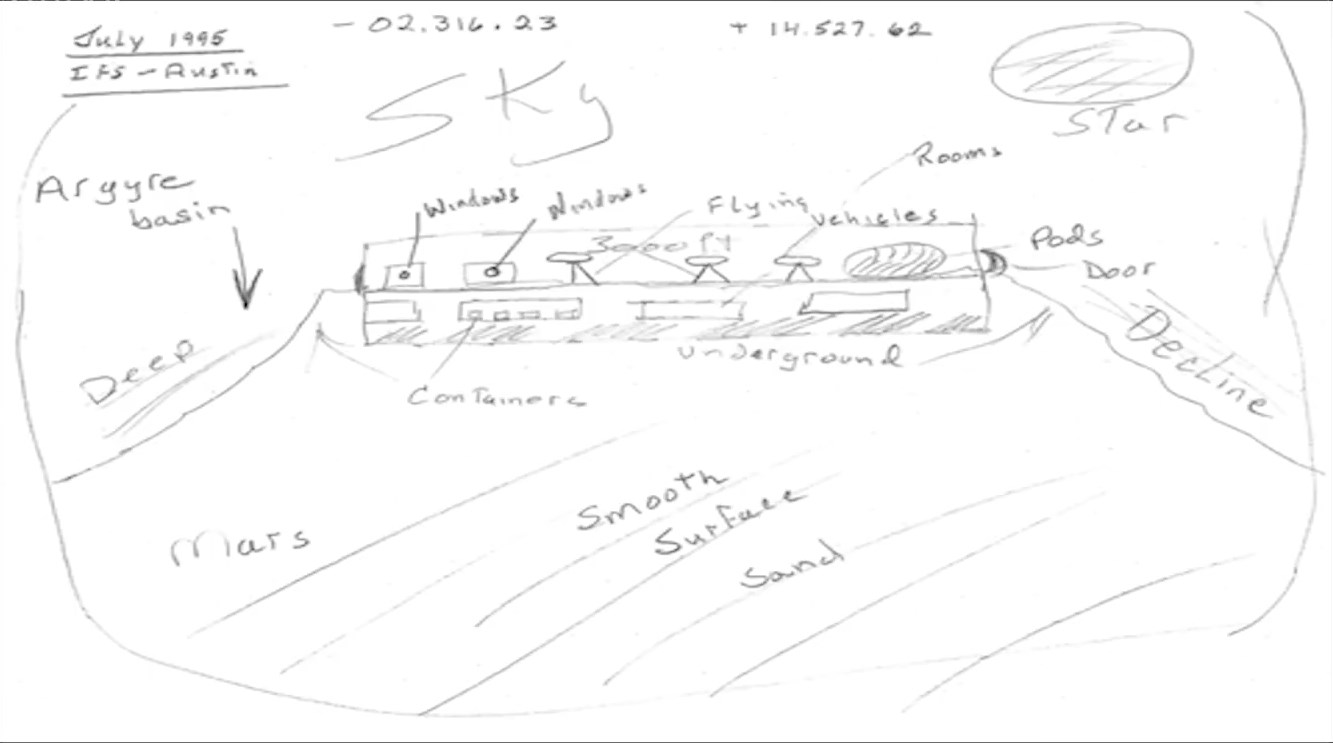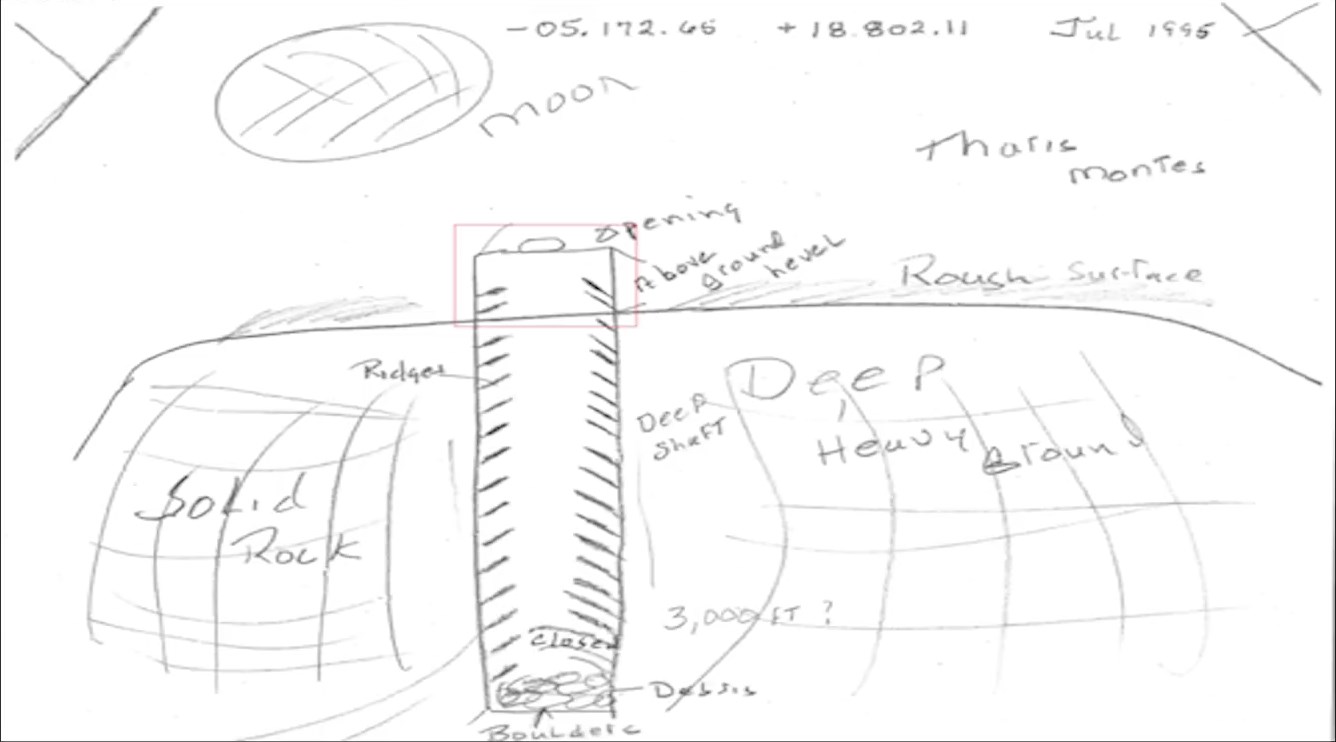Richard Doty:火星の遠隔視
要旨
Richard Doty のひとり語り動画。内容の概要は以下。
こんにちは、私の名前はリチャード・ドティだ。 元空軍特別捜査局の情報将校だ。 今日のプレゼンはドジなものになりそうだ。 リモート・ビューイングについて話そう。 そう、リモート・ビューイングだ。 事実と虚構が入り混じった非常に興味深いテーマだ。 オースティンにある高等研究所でハル・プソフ博士の下で働いていた時、私が目撃したリモート・ビューイングのセッションについて話そう。 (00:00:36)
私が研究所に勤めていたとき、1995年から1999年にかけて4回のリモート・ビューイング・セッションを見学した。 これらのセッションは私的なもので、米国の諜報機関や政府機関とは無関係だった。
前置き
Richard Doty(下)が火星の遠隔視について語っている。

冒頭の派手な音楽で文字起こしが乱れるので、 1:00--20:21 の範囲で文字起こししている。
切り出し静止画



Whisper AI(large-v2 model) + DeepL(2024-07 model)
こんにちは、私の名前はリチャード・ドティだ。 元空軍特別捜査局の情報将校だ。 今日のプレゼンはドジなものになりそうだ。 リモート・ビューイングについて話そう。 そう、リモート・ビューイングだ。 事実と虚構が入り混じった非常に興味深いテーマだ。 オースティンにある高等研究所でハル・プソフ博士の下で働いていた時、私が目撃したリモート・ビューイングのセッションについて話そう。 (00:00:36)
私が研究所に勤めていたとき、1995年から1999年にかけて4回のリモート・ビューイング・セッションを見学した。 これらのセッションは私的なもので、米国の諜報機関や政府機関とは無関係だった。 最初のセッションは、退役軍人のリモート・ビューワーによるものだった。 ターゲットは火星だった。 そう、信じられないかもしれないが、火星だ。 火星のセッションは3種類あった。 最初のセッションは2時間続いた。 リモート・ビューワーは、火星のオーゴラル盆地にある一つの構造物について詳しく説明した。 (00:01:15)
言い方が悪いかもしれないが、スペルはA-R-G-Y-R-Eだ。 その構造物は部分的に地上にあり、残りの部分は火星の地表下にあった。 構造物の大きさは数千フィート、幅は数百フィートだった。 地下部分の寸法はRV車では測定できなかった。 RVというのはリモート・ビューワーのことだ。 RV車は構造物の内部に大きな部屋を観測した。 (00:01:44)
そうだ。 火星の地面や地表に作られた構造物の内部に大きな部屋がある。 生きているものは観察されなかったが、ある部屋の奥深くに容器があった。 RV車はこれを棺桶と見分けた。 RV車はこの地下洞窟で、ある種の空飛ぶ乗り物のようなものを観察した。 これらの乗り物には回転翼があり、側面には大きなタンクのような装置があった。 (00:02:21)
さて、もし誰かが回転翼と側面にタンクを持つ飛行物体について説明していたとしたら、元軍人の私なら、ヘリコプターや空を飛べる何かを思い浮かべるだろう。 元軍人の私なら、ヘリコプターを思い浮かべるだろう。 そこで彼は火星のヘリコプターと名づけた。 リモート・ビューワーは部屋の中にレンガのような構造を観察した。 あなたにはどう聞こえる? (00:02:55)
物置か、人々が住み、仕事をする場所、ヘリコプターがあるので作戦基地かもしれない。 これは、リモート・ビューワーがこれをリモート・ビューイングしたときに考えたものだ。 地表から数百フィート下の深い部分には小さな部屋があり、おそらく居住区であろう。 死体や生物は観察されなかった。
なぜか? 火星の研究、土壌サンプルを見ている専門家、1970年代のバイキング着陸船や過去20年ほどの間に火星に送った他の探査機のことだが、土壌の分析、大気の分析、結論は、火星の歴史のある時期には大気があったということだ。 (00:04:34)
植物が育つ土壌があった。 (00:04:38)
酸素があった。 そして水が見つかった。 地球の北部には水がある。 生命が存在するには、水が必要なんだ。 ETの技術やETの歴史について我々が知っていることを考慮すると、水は惑星が生き残るために必要な普遍的なアイテムだと思う。 そして驚いたことに、彼らは火星で水を発見した。 (00:05:09)
そして一時期、火星には海があったかもしれない。 2回目のセッションは翌日に行われ、火星の別の場所が対象となった。 リモート・ビューワーは火星のタルシス・モンテス地域を観測した。 RVは、部分的に地表の上にあり、部分的に地表の下にある非常に大きな構造物を観察した。 その構造物は厚い壁を持つ重い素材でできており、大きな開口部が大きな構造物の両端に見られた。 (00:05:45)
遠隔視認者は、戻って寸法を決定しようとするよりも、自分が見ているものに関心があったため、寸法は得られなかった。 リモートビューワーは、この施設の両端にスロープがあるのを確認した。 ロケット発射用のポータルか、他のタイプの乗り物の出入り口が観察された。 つまり、居住区、飛行装置、おそらく棺、あるいは後でリモート・ビューワーと話したように、これらのコンテナは火星人が眠る場所だったのかもしれない。 (00:06:28)
しかし今、地下から宇宙への発射地点になりそうな場所を見つけた。 それは何だと考えられるだろうか? 空港かもしれないし、火星の空港かもしれない。 地下に火星の空港を見つけたのかもしれない。 地下から宇宙に向けて乗り物を発射できる施設だ。 ということは、火星にはまだ、地表の地下から宇宙に向けて乗り物を発射する何かがあるという可能性はあるのだろうか? (00:07:02)
さて、リモート・ビューワーは何かを見つけた。 さて、リモート・ビューワーはこれが古いものかどうかを見抜くことができなかった。 歴史的に言えば、彼は自分が見ているものは古いものだと考えていたが、リモート・ビューワーは自分が見ているものすべてを説明することはできない。 つまり、彼が地表で見つけたこの出入り口は、現在も稼働している可能性があるのだ。 3回目のセッションはその3日後に行われ、タルス・モンテスの同じエリアで行われたが、最初の建造物のさらに南だった。 (00:07:42)
RVは、他の2つの構造物よりも小さい別の構造物を発見した。 この構造物は地中深くにあった。 この深い構造物は、地表から約3000フィートの深さで測定された。 ここで立ち止まって、3,000フィートというのは本当に深い、と思うだろう。 通常、地表から3,000フィート(約3,000メートル)もの深さに建造物を建てることはない。 地表の地下3,000フィートにあるものを見つけるのは稀なことだ。 唯一比較できるのは、昔のネバダ州の実験場で、今はネバダ国家安全保障施設と呼ばれている。 (00:08:24)
核兵器の地下実験を行ったとき、地表から3000フィート(約15メートル)下に立坑やトンネルを掘った。 深い構造は幅が小さかった。 深い立坑は壁に沿って隆起していた。 (00:08:39)
畝は壁から突き出ていて、ま�るでかつて他の建造物が立坑の下にあったかのようだ。 3000フィートもある長い立坑に隆起がある。 この稜線は水平なのだろうか? もしかしたら、地表から3000フィート下に人を運ぶエレベーターか何かの装置があったのかもしれないし、3000フィート下に何かを貯蔵していたのかもしれない。 その可能性もある。 リモート・ビューワーは知らなかった。 それはわからなかった。 (00:09:13)
リモート・ビューワーは何かを見ているのであって、これが古い構造物なのか、それともまだ活動しているものなのか、本当のところは分からないことがあることを忘れないでほしい。 立坑の底には物質の塊のようなものがあり、まるでその塊が立坑の以前の部分の廃墟であるかのようだった。 そういえば、立坑には尾根があった。 何らかの建造物、部屋、他の階があって、時間の経過とともにそれらがすべて沈んだか、爆発か何らかの出来事が起きて、これらの階層が何であれバラバラになったのかもしれない。 (00:09:59)
シャフトの頂上、地表のすぐ下にドームのようなものがあった。 ドームには開口部があり、一時は展望口があったのかもしれない。 このシャフトがあり、尾根があり、そしてこのドームがある。 このドームは何のためにあったのか? つまり、ほとんど何でも考えられるということだ。 これが何であったのか、あなたの心はさまようことができる。 (00:10:29)
そこにあるのだから、何かあったのだ。 遠隔地にある。 そしてここにある。 これは、このシャフトのリモートビューワーが描いたスケッチだ。 これを見てほしい。 これは火星の月だ。 この上だ。 この数字が見え��るだろう。 これは彼が実際に火星で見ていた座標だ。 そして日付は1995年7月だ。 (00:11:02)
彼が実際にこれをやっていた時だ。 そしてこれがシャフトだ。 これが上部のドームだ。 この両側の壁に沿って尾根がある。 彼はこの立坑の両側に固い岩と3,000フィートという数字を見つけることができた。 そして底には、おそらく立坑にあった建物の残骸か、この立坑の尾根に沿ってあった床を見つけた。 (00:11:36)
しかしこれは、リモート・ビューワーが火星をリモート・ビューイングしている間に描いた実際のスケッチである。 信じられない。 とてもとても信じられない。 次のリモート・ビューイングは1998年だった。 別の元軍人リモート・ビューワーが木星の衛星エウロパを見ることに同意した。 RV車は木星に面したエウロパの特定の部分を見た。 エウロパの表面は硬く平らだった。 しかし、その下には非常に大きな海が広がっていた。 (00:12:17)
海は深く、長さは数百マイルもあった。 リモート・ビューワーはエウロパの海を泳ぐ物体を観察した。 そうだ。 彼は木星の衛星エウロパを遠隔視したのだ。 これは1998年のことだが、宇宙船がエウロパを訪れ、写真を撮影し、エウロパの表面から土壌サンプルまで採取したことで、私たちは今日知っている。 エウロパの地下に海があることもわかっている。 (00:12:51)
私たちが知っているような水ではないと思うが、このリモート・ビューワーがエウロパを見て、エウロパにあるものを見つけ、水域を見つけ、そして驚くべきことに、この海で泳ぐ何かを見ている。 (00:13:09)
その生物はいくつかの長い付属器官を持っていた。 大きさはやや小さかったが、タコに似ていた。 今、何人かの人々、何人かの生物学者は、彼らは地球原産だと言うだろう。 タコはとても奇妙に見えるし、とても知的だから、何かが起きて、今日私たちが見ているようなタコが地球にやってきたのだろう。 タコはエウロパからやってきたのだろうか? それはわからない。 それはわからない。 しかし、このリモート・ビューワーは、エウロパの月をリモート・ビューイングし、この生物を発見した。 (00:13:51)
その生物は非常に大きな目をしていた。 RVはこの深海から地表に出る2つの開口部を見つけた。 それは丘の近くだった。 丘には人工の穴のような開口部があった。 もう一つの開口部は地表のドリル穴に似ていた。 RVのセッションの終わりに、RVはエウロパの表面を何かが移動するのを観測した。 RVはこの物体を観察した後、視認能力を失った。 (00:14:27)
さて、そのリモート・ビューイング・セッションに話を戻そう。 私たちは別の部屋からリモート・ビューワーを見ている。 彼は目に見えて動揺しているように見えた。 彼はそれが何であるか正確に検出することができなかった。 水面下ではなかった。 海の中ではなかった。 海の上だった。 水面上だったのだ。
(00:15:15)
彼は後でそれを考えた。 彼は実際に見たものだけを報告した。 彼は火星でのリモート・ビューイングのセッションを終えた。 彼は部屋に入り、自分の時間を持った。 ほとんどのリモート・ビューワーは、遠隔で見たものから離れなければならない。 コーヒーを飲んだり、食事をしたりして現実に戻るのだ。 この特別な遠隔視聴者は、何かを食�べなければならなかった。 (00:15:46)
私たちは彼に食べ物を与えた。 それから1時間かそこら経って、彼は開けた場所に来て、今したことを私たちに話し、見たことを説明してくれた。 今、彼は観察したことに自分の考えや意見を入れないように注意しなければならない。 (00:16:20)
本当に優れたリモート・ビューワーは、心の中でそれを分離する。 私にはおそらく無理だ。 私が見たものの中には、私の心の中にあるものや、過去に接触したことのあるものを指しているものもあっただろう。 このリモートビューワーだが、彼はもう軍人ではなかったことを覚えておいてほしい。 これは正式なリモートビューイングではなかった。 私たちはこの情報を他の誰にも提供しなかった。 (00:16:55)
でも私たちがしたことは、彼が私たちにくれたもの、彼が私たちにくれた情報、その何かを、私たちがすでに持っている何かと比較することだった。 信じられないかもしれないが、今日インターネット上に、中央情報局が行ったリモート・ビューイングのセッションの詳細が公開されている。 (00:17:22)
CIAは過去にリモート・ビューワーに火星を見てもらった。 その文書はインターネット上にある。 これは実際のCIAの文書だ。 おそらくCIAのFOIA閲覧室に行って、これをダウンロードできるだろう。 公開された理由は、以前にも公開されていたからだ。 CIAが実際に使っていたリモート・ビューワーの一人が、UFOコンベンションでこのことを話し、実際に何人かの人に見せた。 (00:17:57)
ある特定の人物はウェンデル・スティーブンスだった。 だから、それは世間に公表されている。 だからCIAは公開しなければならなかった。 すでに公開されている。 ウェンデル・スティーブンスからの文書は、他の人が公開したクリアテキストの文書で見ることができる。 では、なぜCIAは火星に興味を持ったのか? その理由のひとつは、ソ連がかつて火星に着陸し、火星に基地を作ろうとしたと考えていたからだ。 (00:18:30)
CIAが火星で起きていることを知っていたのか、あるいは火星で起きていることを察知することができたのか、それについては多くの陰謀説がある。 なぜCIAはソビエトがやっていると考えたのか? おそらくソ連の偽情報だろう。 我々はソ連に偽情報を提供している。 その昔、彼らも私たちに同じことをしていたはずだ。 彼らは火星にロケットを送り、火星に基地を建設するというストーリーを打ち出した。 (00:19:03)
そんなわけで、CIAは火星に非常に興味を持っていた。 火星でのリモート・ビューイング・セッションに関するこのプレゼンテーションを楽しんでいただけたなら幸いである。 次回まで、リチャード・ドティだ。 ご清聴ありがとう。 (00:19:20)
▼文字起こし 原文 展開
Hello, my name is Richard Doty. I'm a former intelligence officer with the Air Force Office of Special Investigations. Today's presentation is going to be a doozy. We're going to talk about remote viewing. Yes, remote viewing. A very interesting subject where there's a lot of fact and fiction involved. But we're going to talk about what I saw in the remote viewing sessions that I witnessed while I worked for Dr. Hal Puthoff at the Institute for Advanced Studies in Austin. (00:00:36)
While I was employed at the Institute, I observed four remote viewing sessions between 1995 and 1999. These sessions were private, not connected to any U.S. intelligence or any government agency. The first session was done by a retired military remote viewer. The target was Mars. Yes, believe it or not, Mars. There were three different sessions for Mars. The first session lasted two hours. The remote viewer described in details one structure that was located in the augural basin of Mars. (00:01:15)
I might not be saying that right, but it's spelled A-R-G-Y-R-E. The structure was partially above ground with the remaining part under the surface of the planet. The structure measured several thousand feet and several hundred feet wide. The dimensions of the underground portion was not measured by the RV. And when I say RV, I'm talking about the remote viewer. The RV observed large rooms inside the structure. (00:01:44)
Yeah, you heard me. Large rooms inside the structure on a structure that's built into the ground or the surface of the planet Mars. No living entities were observed, but deep inside one of the rooms were containers. The RV distinguished these as coffins. The RV observed what was described as some sort of flying vehicles in this underground cavern. These vehicles had rotary blades and a large tank-like device on the side. (00:02:21)
Now, if somebody was describing a flying craft with rotary blades and a tank on its side, I, being ex-military, would think of a helicopter, something that could fly. The RV considered what he was seeing to be something like a helicopter. So he named it a Martian helicopter. The remote viewer observed brick-like structures within the rooms. So what does that sound like to you? (00:02:55)
A storage area or some place where people lived and worked out of, maybe a base of operations because of the helicopters. This is what the remote viewer considered when he was remote viewing this. The deep part of the structure, several hundred feet below the surface, contained small rooms, possibly living quarters. No bodies or creatures were observed. So now we found an area that could be living quarters for Martians or for the civilization that lived on Mars hundreds of thousands of years ago. (00:03:38)
Now, most practical astronomers and other scientists considered that the possibility of life on Mars existed, but maybe thousands or hundreds of thousands or maybe even a million years ago. Why? The study of the planet Mars, the experts that are looking at the soil samples, and we're talking about the Viking landers of the 1970s and the other crafts that we sent to Mars over the last 20 years or so, the analysis of the soils, the analysis of the atmosphere, the conclusion is that at one time in Mars history, there was an atmosphere. (00:04:34)
There were soil that could grow plants. (00:04:38)
There was oxygen. And then they found water. There's water in the northern portions of the planet. So in order to have life, we have to have water. And I think considering what we know about ET technologies and ET's histories over the years, water is pretty much the universal item that a planet needs to survive. And lo and behold, they found water on Mars. (00:05:09)
And at one time, there might have been oceans on the planet. The second session occurred the next day and involved a different location on the planet. The remote viewer observed the Tharsis Montes area of Mars. The RV observed another very large structure that was partially above and partially below the surface. The structure was made of a heavy material with thick walls, large openings were observed at both ends of the large structure. (00:05:45)
No dimensions were obtained because the remote viewer was more concerned about what he was seeing rather than going back and trying to determine dimensions. The remote viewer observed ramps at each end of this facility. A portal for a launch vehicle or some other type of vehicle entry and exit points were observed. So now we found not just living quarters, flying devices, and possibly coffins, or maybe even as we talked about later with the remote viewer, maybe these containers were where they slept, where the Martians slept. (00:06:28)
But now we found an area that could be a launch point from underground out into space. So what would that be considered? Maybe an airport, maybe a Martian airport. Maybe he just found a Martian airport underground. A facility that could launch vehicles from underground out into space. So is it possible that there's still something on Mars that is launching vehicles from the ground under the surface into space? (00:07:02)
Well, the remote viewer found something. Now the remote viewer couldn't detect whether this was old. Historically speaking, he thought what he was looking at was old, but remote viewers can't really explain everything that they're seeing. So this entry and exit point that he found under the surface could be still in operation today. The third session occurred three days later and involved the same area of Thars Montes, but further south of the first structure. (00:07:42)
The RV located another structure that was smaller in size than the other two. This structure was deeper into the ground. The deep structure was measured at approximately 3000 feet under the surface. Now you stop and think 3000 feet is really, really deep. We don't normally build things 3000 feet under the earth's surface. It's rare to find anything that deep under the surface. The only thing I can compare this to is the old Nevada test site, which is now called the Nevada National Security Site. (00:08:24)
When they did underground testing of nuclear weapons, they would dig shafts or tunnels 3000 feet under the surface. The deep structure was smaller in width. The deep shaft contained ridges along the walls. (00:08:39)
The ridges protruded from the walls as if some other construction was once down the shaft. Now it's a long 3000 foot shaft with ridges. Now could these ridges be levels? Maybe there was an elevator or some sort of device that took people from the surface down 3000 feet or stored something 3000 feet. That's a possibility. The remote viewer didn't know. I couldn't tell that. (00:09:13)
Remember, remote viewers are looking at something and can't really tell at times whether this is an old structure or something that is still active. The bottom of the shaft contained what appeared to be chunks of material as if the chunks were ruins from some previous part of the shaft. Remember, there were ridges in the shaft. Could have been some kind of construction, rooms, other floors, and over time they all sunk or some explosion or some event occurred that broke up whatever these levels were. (00:09:59)
On the top of the shaft, just under the surface, was a dome-like structure. The dome had openings that at one time might have contained viewing ports. Now we got this shaft, we got ridges, and now we have this dome. What was this dome for? I mean, only, I mean you could think of almost anything. Your mind can wander about what this could have been. (00:10:29)
It was something because it's there. It's remote viewed. And here we are. These are the actual drawings, sketches made by the remote viewer of this shaft. You're seeing these. You can see this is the moon, the moon of Mars. This is up here. You can see these numbers. That's the coordinates that he was actually viewing on Mars. And then the date, July 1995. (00:11:02)
That's when he was actually doing this. And here's the shaft. Here's the dome on top. Here's the ridges along this wall of both. Now he could detect on both sides of this shaft solid rock and the number 3,000 feet. And at the bottom he found the debris, possibly the remnants of a building that was in the shaft or floors that were along these ridges in this shaft. (00:11:36)
But this is the actual sketch that the remote viewer made while he was remote viewing the planet Mars. Unbelievable. Very, very unbelievable. The next remote viewing I observed was in 1998. Another former military remote viewer agreed to view Europa, a moon of Jupiter. The RV viewed a particular portion of Europa facing Jupiter. The RV found a hard, flat surface on Europa. But underneath the surface was a very large ocean or body of water. (00:12:17)
The ocean was deep and hundreds of miles long. The remote viewer observed an object swimming in the ocean of Europa. Yes, you heard me right. He remote viewed the moon of Jupiter, Europa. Now we know today, and this was in 1998, we know today because we've had spacecrafts visit Europa, photograph and even soil samples from the surface of Europa. We know that there is an ocean under Europa. (00:12:51)
We don't think it's water as we know it, but here's this remote viewer viewing Europa, finding things on Europa, finding a body of water, and then amazingly seeing something swimming in this ocean. (00:13:09)
The creature had several long appendages. The creature was somewhat small in size, but resembled an octopus. Now some people, some biologists would say that they are native to Earth. They seem so strange and they're very intelligent that something happened that brought these octopuses that we find today to Earth. Now did they come from Europa? I don't know. I can't say that. But this remote viewer, remote viewing the moon of Europa, found this creature. (00:13:51)
The creature had very large eyes. The RV found two openings from this deep ocean area onto the surface. It was near a hill. The hill had an opening similar to a man-made hole. The second opening looked similar to a drill hole in the surface. During the end of the RV session, the RV observed something move across the surface of Europa. The RV lost his viewing capabilities after observing this object. (00:14:27)
Okay, let's take us back there to that remote viewing session. We're watching the remote viewer from another room. He seemed to be visibly upset or had emotions displayed when he saw something moving across the surface. He couldn't detect exactly what that was. It wasn't under the surface. It wasn't in the ocean. It was above the ocean. It was on the surface. Could he have detected one of the octopuses or one of these creatures that was swimming in the ocean move from the body of water onto the surface? (00:15:15)
He considered that later. He only reported what he actually saw. He ended the remote viewing session up Mars. He went into a room and he had some time to himself. Most remote viewers have to come away from what they just remote viewed. They have to come back to reality by drinking a cup of coffee or eating. This particular remote viewer had to eat something. (00:15:46)
We gave him some food to eat. And then about an hour or so later, he came into an open area and talked to us about what he just did and explained to us what he saw, showing us these diagrams, which you saw here today, both of them, and then talked about it. Now, he has to be careful of not putting thoughts or his opinions into what he observed. (00:16:20)
Some really good remote viewers will isolate that in their minds. I probably couldn't do it. I would guess that some of the things I saw were something that would be in my mind or something referring to something that I've had contact with in the past. This remote viewer, but remember, he wasn't military anymore. This wasn't an official remote viewing. We didn't provide any of this information to anybody else. (00:16:55)
But what we did was we compared what he gave us, the information he gave us, that something to something that we already had. And believe it or not, on the internet today, and I have a copy of it, is a detailed of a remote viewing session that the Central Intelligence Agency did. (00:17:22)
The CIA had their remote viewers view Mars in the past. That document is on the internet. This is an actual CIA document. You probably can go to the CIA FOIA reading room and download this. And the reason that they released it to the public is because it has been released before. One of the actual remote viewers used by the CIA talked about it at the UFO convention and actually showed it to some people. (00:17:57)
One particular person was Wendell Stevens. So that's out there in the public. And that's why the CIA had to release it. It's already out there. Some of the things that were redacted in it, you can see in the clear text documents that other people have released that came from Wendell Stevens. So why was the CIA interested in Mars? Well, one reason is they think the Soviet Union at one time landed on Mars and even tried to build bases on Mars. (00:18:30)
Now there's a lot of conspiracy theories out there about that, about whether the CIA knew or could detect things that are occurring on Mars. Why did they think the Soviets were doing this? Well, it was probably Soviet disinformation. We provide disinformation to the Soviet Union. And I'm sure back in those days, they did the same to us. They set out a story that they were sending rockets to Mars and building a base on Mars. (00:19:03)
And that's why the CIA was extremely interested in the planet Mars. I hope you enjoyed this presentation on the remote viewing session on Mars. Until next time, this is Richard Doty. Thank you for listening. (00:19:20)
動画(21:21)
Inside the Shadow World of Remote Viewing…The Doty Chronicles www.youtube.com/watch?v=1hYbSUXI9W8
動画概要欄
26,900 views Premiered Apr 7, 2024
@UAMNTV In this episode of Season 2 of The Doty Chronicles, Richard Doty discloses never-before-publicly-released information on one of the US government's most secret programs: remote viewing. What is remote viewing? How was it used to obtain UFO and ET information? What did remote viewing see on Mars?
(2024-08-16)